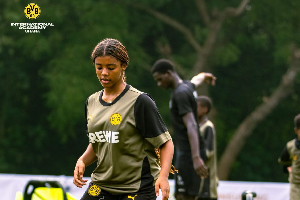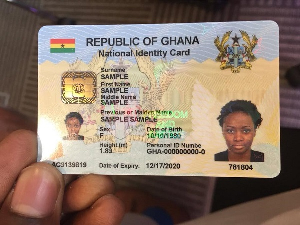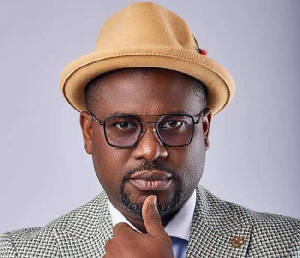– By Nana Yaw III. Feb. 6, 2013
For the past week the airwaves, print media (newspapers – hard and soft) have been flooded with news of Oye Lithur and her stand on homosexuals. I have heard and read from many – prophets, apostles, bishops, pastors, politicians, and moralists – of the crime Oye is committing in this country, and the need for the President to reconsider her appointment. Whilst this was happening, the three institutions established and supported by the tax-payer’s money to provide electricity to the nation (the VRA, GRIDCo/NEDCo, and ECG) have as individuals or acting in a coalition of two or three, failed to provide us regular power, and embarked on an unprecedented power shedding exercise with the excuse of the need to shut down the Takoradi Thermal Plant for routine maintenance. As if this were not enough, The Ghana Urban Water Limited, has also decided to shut down [part of?] the Weija Treatment plant in part, to enable them change some filters which have functional problems.
Dwellers in most parts of Accra are, as a result of these measures, living in darkness and without water and, have no clear idea of when this problem is going to be solved. What I find missing in this drama are the voices and writings of those prophets, apostles, bishops, pastors, politicians, and moralists, denouncing the denial of the citizenry of two basic necessities of modern-day living – electricity and water. These people have kept mute, possibly because they prefer to live in darkness, so that they can have a field day in undertaking their nefarious activities, which are better done in the darkness than in the light. They have kept mute for all this time because they prefer to anoint their heads with olive oil than bath with water to clean their bodies of the filth acquired from their nefarious activities. They can choose to go dumb, but I am not going to do so and will therefore use this opportunity to address the institutions mentioned above.
THE POWER GENERATORS/TRANSMITTORS AND DISTRIBUTORS
1. VRA: According to them, “The Volta River Authority (VRA) was established on April 26, 1961 under the Volta River Development Act, Act 46 of the Republic of Ghana, as a corporate body with the mandate to operate mainly as a power generation, transmission and distribution utility. In 2005, following the promulgation of a major amendment to the VRA Act in the context of the Ghana Government Power Sector Reforms, the VRA's mandate was revised and has now been largely restricted to generation of electricity. “The transmission function has been hived off into a separate entity, designated National Grid Company [GRIDCo] to perform the transmission activities. In the transition process VRA has operationalized its distribution agency the Northern Electricity Department [NEDCo] as a subsidiary company.
1a. GRIDCo: According to them their mission is: “To provide open access, non-discriminatory, reliable, secure, and efficient electricity transmission services and wholesale market operations to meet customer and stakeholder expectations within Ghana and the West African Sub-region, in an environmentally sustainable and commercially viable manner.”
1b. NEDCo: According to NEDCo, their mission is “To procure and supply quality electricity, reliably, efficiently, safely in a sustainable manner to meet customer demand and stakeholder expectation in Ghana and the West African sub region.”
2. ECG: Among others, the ECG gives a brief of itself as follows: “Electricity Company of Ghana is a limited liability Company wholly owned by the Government of Ghana and operating under the Ministry of Energy (ME). The Company was incorporated under the Companies Code, 1963 in February 1997. It began as the Electricity Department on 1st April 1947 and later became the Electricity Division in 1962. It was subsequently converted into the Electricity Corporation of Ghana by NLC Decree 125 in 1967. Until July 1987, the responsibility for distributing and supplying power in the country rested on ECG. The Government created the Northern Electricity Department (NED) as a subsidiary of Volta River Authority (VRA) in 1987 which took over from ECG the responsibility for the running and development of electric power systems in Brong Ahafo, Northern, Upper East and Upper West Regions. The Company is responsible for the distribution of electricity in the southern part of Ghana namely, Ashanti, Central, Eastern, Greater Accra, Volta and Western Regions.”
“The Company is charged with the under-mentioned responsibilities: To transmit, supply and distribute electricity; To purchase electricity energy in bulk (from the Volta River Authority) or any other supplier for distribution; To construct, reconstruct, install, assemble, repair, maintain, operate or remove sub-transmission stations, electrical appliances, fittings and installations; To execute national electrification programmes on behalf of Government; and, To carry out any other activity incidental or conducive to the attainment of the objectives specified in the instruction above.”
These institutions – manned by hundreds of executives, thousands of employees, vehicles and equipments – are sustained by the tax-payer’s money, and yet cannot work to provide regular power supply to a small country like Ghana.
Starting with the VRA, this company is supposed to be generating power at the Akosombo (Hydro and Retrofit) plants, the Kpong Hydro Plant, The Takoradi Thermal Power Station (TTPS), and The Tema Thermal Power Complex (TTPC). Late last year the nation suffered power supply setbacks, which were attributed the shortage in the supply of gas as a result of a disruption in the operations of the West Africa Gas Pipeline. We held on with impatience till the last days of December, when the repair was supposed to have been completed. Sources indicate that till now the pipeline issue is yet to be resolved. We hoped things were going to improve in the power supply sector, but all of a sudden we witness another break in power supply. A few days ago, the VRA came with the following press release:
“VRA Planned Maintenance: The Management of the Volta River Authority wishes to inform the general public that Unit SC 2 at the T2 plant (TICO) at Aboadze will be shut down for combustion inspection works from 00:01hrs on Friday, February 1, 2013 to 23.59hrs on Thursday, February 7, 2013. Additionally, Unit SC 1 of the plant will also be shut down for Hot Gas Path Inspection from 00:01hrs on Friday, February 8, 2013 to 23.59hrs on Sunday, February 24, 2013. The Authority wishes to bring to the attention of the general public that the above inspection works will result in an additional shortfall in power generation by 110MW. We wish to assure our valued customers and the general public that the VRA is committed to ensuring the supply of adequate power in the country. Issued By: CORPORATE COMMUNICATIONS UNIT Date: February 1, 2013”
With this release, they went back to their comfortable homes and offices and left us to be sweating in ours, and without power to work. What I find incomprehensible is that for months, these plants that are being closed down for maintenance (after better arrangements for the supply of alternative fuel has been made) were partially lying idle because there was no gas to fire them. Could these guys not have thought it wise to “forward” the maintenance work during this time of “idleness” so that when constant fuel supply is restored they would have resumed normal operations without disturbing consumers now with a “planned maintenance?”
Enter the Achimota sub-station transformer fire. According to initial reports, 1 out of 9 transformers got burnt in the fire, leaving 8 operational. In that same report an officer from GRIDCo, Mr. Albert Quainoo, in media report on Jan. 28, said that power from the Adjiringano substation (which had a 132MVA capacity but was using only 31MVA) would be transferred to the affected customers. He added that the Mallam substation which had an upgraded facility could also be called in to ensure there was no interruption in power supply to consumers. He told the Daily Graphic that the company had spare transformers in Tema, and that one of such transformers would be brought in to replace the burnt one. He told Ghanaians that rehabilitation work had already started but the installation process will take a time span of 4 weeks! 4 weeks to install a transformer in an already established power substation?
In another interview, he was even audacious to tell Ghanaians that no consumer can sue GRIDCo for what happened because their mission is to transmit generated power to customers and avoid the monopoly of power supply in the country. Yes, that is the extent to which we have cultivated our state and public institutions – nurture and insulate them from all harm, to the extent that the executives we pay with the taxpayer’s sweat tell us that we cannot sue them for their failures or for causing us discomfort and harm. By the way what does GRIDCo use to transmit power?
Whilst I was battling to disentangle my thoughts from the mess of Mr. Quainoo’s remarks, another gentleman from GRIDCo (Mr. Modey) appeared on the scene to compound my confusion by telling Ghanaians (Citi Breakfast Show Friday 1 February) that it was 1 out of 5 transformers that got burnt. Amidst all these they were able to tell us that the cost of bringing things back to normal was $1.3 million ($1.2 million in replacement and $100,000 in installation).
Ghanaian executives are good at coming up with figures to justify expenditure but lack the same speed and efficiency at executing the projects for which they cook up figures at lightning speed. Thus some hours after the fire, these guys were able to quote the cost of the project, but were sluggish in determining the time frame for terminating the installation of the burnt transformer. To me, the only factor that can lead to such a long delay in installing a new transformer at the site is the preparation of a new concrete base on which the transformer is to be installed. Is this the case at Achimota? I doubt it. If not, then I beg to know why they need 4 weeks in replacing a burnt transformer.
To end the power issue, somebody accused me yesterday of “knowing too much” because I said VRA is running an over-staffed company and that most of their executives take great remunerations and work for less. Secondly s/he said the low tariff paid by government on power generated is the cause of non-attraction of investors to the generation sector. This is not necessarily true. Small time investors can enter the fray (e.g. Solar sector) if there is a proper regulatory framework and people can easily sell their production to GRIDCo/NEDCo. With an ease of sale to the buyer, small solar farms will spring up like mushrooms all over the country. Even households, which install solar panels to provide power in their homes, and industries that install solar power to power their businesses, can sell the excess to GRIDCo/NEDCo. What we need is a good regulatory framework and a business-sensitive tax regime.
REFLECTIONS ON THE POWER SECTOR: For small country like ours whose sole operator/regulator in the power sector is the government of Ghana, is it not too much for the state to fund so many limited liability companies to generate, transmit and distribute power? Does such a situation not create room for the high cost of power generated? Is this situation a cost-effective and sustainable one?
THE GHANA WATER COMPANY LIMITED AND WEIJA TREATMENT PLANT SHUTDOWN
Before proceeding I will give a brief of the Ghana Water Company Limited (GWCL). This company was established on 1st July 1999, following the conversion of Ghana Water and Sewerage Corporation into a state-owned limited liability company under the Statutory Corporations (Conversion to Companies) Act 461 of 1993 as amended by LI 1648. According to them, their vision is to be “a world class utility company delivering quality and acceptable services based on our distinctive competence and best practices in the water industry.” They state their mission as follows: “We are committed to meeting the increasing demand for better service delivery through efficient management of our core business of production and distribution of potable water and customer management in urban areas of Ghana.”
They define their core values to include: Quality and excellent customer service; Commitment to speed and urgency in our service delivery; High level of integrity and honesty; Continuous improvement and innovation; Health care and safety of stakeholders; High ethical and professional standards; and, Community and environmental care.
Their core businesses are: Urban water sector planning and development; Investment planning; Sector financial management; Contracting out the design, construction, rehabilitation and expansion of existing as well as new works; and, Assets Management.
In spite of these wonderful visions, missions, values and core businesses, the non-performance of this institution led to the signing of a 5-year management contract in November 2005 with a private company – Vitens Rand Water Services BV of Netherlands – which commenced on 6th June 2006, and was run by Vitens Rand Water Services BV’s subsidiary, Aqua Vitens Rand Limited (AVRL).
According to GWCL assessments, the operations of the management company did not impact significantly on the performance of the company. The resultant decision was to establish the Ghana Urban Water Limited (GUWL), to take over the management of urban water systems in the country temporarily; a move that was considered by the Ministry of Water Resources Works and Housing, as “the most attractive short term option to allow government to take stock and seamlessly manage the operations of the urban water systems for a period of only 12 months.”
About a week ago we read the news of a proposed shut down of the Weija Treatment plant, with the justification that 4 of 12 filters were faulty and required immediate rehabilitation. The process of rehabilitation implied a reduction of water supply to the Accra-Tema area, and this has already started. What I do not understand is that the executives and overseers of the Weija Water system never saw this coming till 4 filters had gone bad. What happened to routine maintenance and inspection? These executives religiously collect their pay, their bonuses, and enjoy other pluses attached to their positions but care very little to maintain and efficiently run the services for which they are employed.
Following this announcement, the Public Utilities Regulatory Commission (PURC) on January 31 directed GWCL not to ration water during the repair works on the 4 filters at the Weija Treatment Plant. Interacting with media personnel during a tour of the site, Dr. Emmanuel Annan, Chairman of PURC pointed out that GWCL had been resourced enough by the Commission and that it had no excuse to shutdown the filters before repair works. [Oh! I wish there were more leaders with such wisdom and sense of responsibility to challenge and compel colleagues to do the right thing.]
In an interview on Joy FM’s morning show yesterday (Feb. 5), Mr. Stanley Martey, stated that the water crisis will endure until 2014 when work on the Kpong water treatment plant is expected to be completed.
The preceding three paragraphs tell a bit of what is happening in our public sector institutions. We have a communications director who announces that as a result of problems with one-third of the total filters of a treatment plant, they were going to shut down the system (part) and ration water for six months. Fortunately for consumers, the head of the PURC decided to take the managers of the treatment plant to task with a threat to sanction them if they continued with their planned exercise. This threat seems to have brought some sense into the planning process of the rehabilitation exercise, and so consumers may not suffer as much as initially planned.
Mr. Martey’s further assurances of a resolution of the water problem, once the Kpong Rehabilitation program was concluded in a year’s time was however not conclusive as according to him “It will improve on coverage of water from the current 60 percent to about 90 percent, which means that we are going to have more water such that the rationing programme may even end.” He goes on to add that “If it doesn’t end or some areas wouldn’t get water then it means they do not have distribution mains within their communities.” And concludes, among others that “hopefully [in] 2014 the rationing programme may end or may not be severe as it is.” These are the projections and solutions that an institution, charged with the provision of potable water supply to a growing city, provides for the suffering taxpayers.
Before I proceed, I will like to state that the subsoil of Ghana is known to contain so much underground water. And hundreds of individuals in and around Accra have dug boreholes to supply water to their households. My question is why can’t the GWCL identify some abundant sources of underground water around the Accra-Team areas, and extract these sources to supplement those from Ayensu and the Volta whilst we are waiting for the completion of the Kpong Water Expansion project?
I see a problem with potable water management in the country. This problem is called CENTRALISED MANAGEMENT. Though, not only peculiar to the potable water supply sector, over-indulgence in a centralised system is the root cause of the inadequate and/or absence of regular potable water supply in our communities. In a country whose leaders embarked on a DECENTRALISATION drive over two decades ago, we have only concentrated this on the political aspects of our lives and left out the administrative, managerial and services aspects.
For some time now, I have been cracking my head, looking for the best way to resolve this water problem once and for all, and came to the conclusion that the problem was easier to solve if tackled from the grassroots. I make some travels around the world, but I always go back to my native village anytime I come back to Ghana. Some years back, when I was a kid, we had a pumping machine that supplied water in the village, and was operated by the then Ghana Water and Sewerage Corporation. This machine broke down and was never repaired. That meant no more pipe-borne water. Then in the mid-‘80s three boreholes were drilled in my village to supply water. They also broke down after a few years. The main source of water to the village, in the absence of these governmental attempts, was a perennial stream on the mountain side of the village. In the mid-‘90s, a Dutch couple (the man was a hydro-engineer) visited the area, saw the problems that the old folks in the village were going through to get water from the mountain-side and decided to help.
What did they do? The man advised that a small dam was built to store some of the water uphill and then a pipeline laid to channel the water to a reservoir that had been in existence for decades. As the reservoir was located on the lower side of the dam, there was no need for a machine to pump the water. The town was also located below the reservoir, so everything worked by gravity. My village has since had regular pipe-borne water. We did not wait for government to provide us water. The system is managed by a community-based team and consumers pay for what they use. This is a grassroots, and decentralised solution that could be applied to every single community in this country in the following manner.
The water management system in the country should be DECENTRALISED and made the responsibility of the Metropolitan, Municipal and District Assemblies (MMDAs). When any of these Assemblies is given the responsibility of providing its own potable water supply system, all that the unit has to do is to put up a tender for the supply of water by individuals, groups of individuals, and/or companies. Preference should be given to persons or entities that reside in the concerned localities. The tender should include a proposal on how the applicant was going to fund the project, what quantity of gallons of water the applicant could supply per day, how long it will take the applicant to execute the project to make the water available, and how long it will take the applicant to break-even and recover the investment made.
To ensure the quality and purity of water thus supplied, the GWCL should act as a facilitator and overseer of the activities of the contracted supplier.
To ensure the levying of reasonable prices, the GWCL and other stake holders, including the Assemblies, must work hand in hand to decide what tariffs are to be paid.
Other technicalities have to be worked out but I am optimistic that if such a step is undertaken communities in the Accra-Tema areas such as Adenta, Teshie, Nungua, etc that have water supply problems will definitely have regular water supply all year round.
What is more important here is that 1. The government of Ghana will not always have to go out seeking loans to provide water 2. The revised mission of the Ghana Water company will then become that of Facilitation; Regulation; Inspection; Standardisation; and Bulk water provision 3. Local investment opportunities for individuals and/companies resident in the areas leading to job creation.
I call on the government of Ghana to set up a team to undertake this exercise on pilot basis, say in the Adenta community, and we will see what a difference it will make at no cost to the tax payer. What we need in Ghana is a proper regulatory framework from government and this nation will move forward in many aspects of our lives without the need for government to go for loans and indebt our nation.
Finally, as regards the cries against Oye Lithur, I only wish that the puritans will undertake similar battles against bribery, corruption, lateness and absenteeism at our workplaces. To me, these are greater evils that destroy our social fabric more than the threat of the recognition of homosexuals.
May God Bless Our Homeland Ghana! Nana Yaw III (nanayawiiigh@gmail.com) Feb. 6, 2013
Opinions of Monday, 11 February 2013
Columnist: Yaw III, Nana














